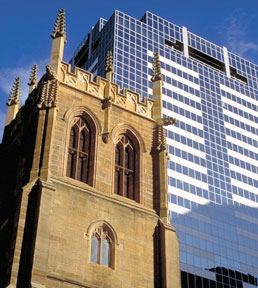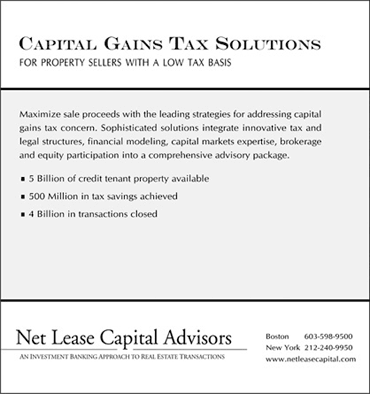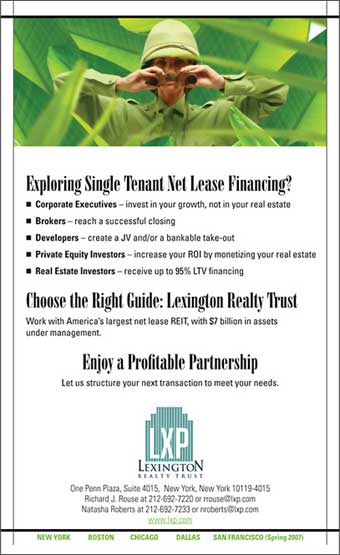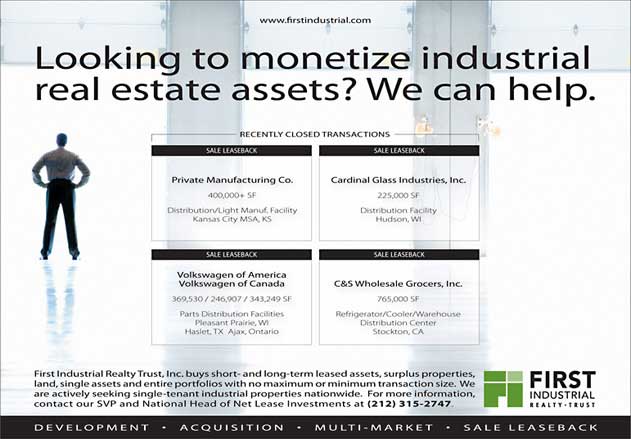
SALE/LEASEBACK TRANSACTIONS
THE POSSIBLE:

ompanies may come in all shapes and sizes, but all of them at some point need ready cash in order to meet business goals. Many choose to tap the value of their real estate assets in order to finance growth, pay down debt, buy back stock or tidy up their balance sheets.
Sale/leaseback arrangements – whereby a firm sells part or all of its property holdings and enters into a long-term net lease with its new owner – remain highly popular instrument through which businesses can monetize their real estate. In 2006, such deals occurred at a healthy clip, and industry leaders expect even more to occur this year. “The market’s going to be stronger in 2007 than it was last year,” predicts Richard Ader, chairman of U.S. Realty Advisors, LLC, in New York City. Ader, who has been active in sale/leaseback deals since 1968, says his company participated in more than half a billion dollars worth of them in 2006.
Sale/leasebacks can occur on any kind of commercial property – from paper mills to movie theaters, from medical offices to shopping centers. There are even deals in the works for educational buildings at private schools. Ader says most of the activity he sees right now is in the office sector, restaurants and in distribution centers. “It’s pretty well across the board today,” Ader says.
Equally diverse are the financial benefits companies can derive by selling real estate assets and leasing them back. They have proven timely for firms in consolidating industries – telecommunications, the most recent example – who are facing the twin objectives of raising cash and trimming down physical plant.
But there is a more generic business reasoning behind the rush in recent years of firms to offload property ownership through sale/leasebacks. “Companies these days are more conscious about where their capital is, and they want to deploy that capital as efficiently as it can,” explains Ben Harris, managing director of W.P. Carey & Co., LLC, the New York-based real estate investment firm with an 800-property portfolio. Sale/leaseback transactions have surged as firms strive to concentrate their energy and financial resources on core business functions, Harris says.
At the heart of sale/leaseback arrangement’s appeal: flexibility. “As the industry has grown, the arrangements have become more sophisticated,” Harris says. Leasing arrangements can be custom-tailored around any firm’s unique business objectives and property management needs. Some firms want to extract the maximum equity from their real estate as quickly as possible, while other will swap a more modest selling price for a discounted rent – or, in some cases, no rent for a certain period. “There is no one-size-fits-all deal,” explains Harris.
W.P. Carey & Co., LLC
Leasing terms are typically long-range – 15 years and greater – but even that is negotiable, depending on a tenant’s strategic plans. Bruce MacDonald, president of Net Lease Capital Advisers, says one of his company’s recent deals centered on a 17-year lease, an oddly specific timetable. “The company wanted to align the leasing terms with those of several other properties it owned,” explains MacDonald, who is based in Nashua, N.H. Terms also can address building improvements that are needed and contingencies for future expansion.
For some sale/leaseback deals, a speedy closure is critical. “Often times, some publicly traded companies are trying to do something by the end of a quarter or the end of the year,” MacDonald explains. “That’s fairly common.” Though the typical sale/leaseback closes in 60 days or so, it is possible to slam-dunk a closing in half that time. “It can be done quickly,” says MacDonald, who’s firm has closed deals in as few as 30 days. When delays do occur, they can usually be traced to the seller. “Time is consumed in the structuring of the lease,” MacDonald continued, “and the tenant usually drives that part of the process.”
Nor is it only existing properties that can be part of a sale/leaseback arrangement. Real estate investment firms can collaborate with developers and tenants on build-to-suit projects. Office properties, especially corporate headquarters operations and downtown “trophy” towers, are frequently developed via sale/leaseback agreements. Tenants get high-quality space tailored to their needs without having to undertake their own investment.
“Build-to-suit projects are a little more cyclical,” says W.P. Carey’s Ben Harris. But such deals help firms like his weather the often counter-cyclical nature of sale/leasebacks on existing properties. “In tougher economic environments, firms look to raise money,” Harris explains.
One new trend real estate professionals are noting is the increasing interest in sale/leaseback agreements by private equity interests.
“Private equity firms have come to realize they can use sale/leasebacks on their acquisitions,” reports Robert Micera, senior vice president and national head of net lease investments at First Industrial Realty Trust, Inc. Sale/leasebacks are an especially strong solution for mid-sized companies, he says.
Yield hungry pension fund managers have also become eager players in the sale/leaseback market. “Pension funds are very interested,” says Micera, whose company owns some 100 million square feet (9.2 million square meters) of real estate.
The surge of interest by the investment community has made the market for sale/leasebacks more competitive, Micera says. As a result, investor focus has been drawn out across the risk spectrum to properties and sellers at the sub-investment grade level. When designing sale/leaseback deals, Micera examines three key factors: real estate attributes, the credit quality of the business and the structure of the lease itself. “A desirable location can offset weakness in the tenant’s business model,” he explains. Similarly, less appealing properties can be attractive investments if they are central to a promising company’s long-term business plans. “You have to blend all these components together to make sure the deal makes sense,” says Micera.
The marketplace for sale/leasebacks is also an increasingly global one. Half the deals put together by W.P. Carey, for instance, are in Europe. And sale/leasebacks have become a popular means by which overseas investors plant their flag in the U.S. real estate market.
“Foreign investors are hugely interested in this,” reports Paul McDowell, chief executive officer of Capital Lease Funding, Inc., a New York City-based net lease REIT whose commercial real estate interests are oriented toward office properties for high credit-quality tenants. “The quintessential foreign investor is looking for high-grade, long-term real estate investments,” McDowell explains. Of great appeal are large office properties in central business
come to realize they can use
sale/leasebacks on their
acquisitions.”
national head of net lease investments,
First Industrial Realty Trust, Inc.
districts of major American cities, he says.
While investors look hard at the financial viability of prospective leasees, it is also advisable for sellers/leasees to examine the experience, stability and long-range commitment of buyers/landlords. “The big thing to focus on is finding the right buyer for each type of asset,” advises W.P. Carey’s Ben Harris. Sellers should seek out investors capable and willing to be flexible with leasing terms in order to accommodate unanticipated changes in business needs.
“It’s tough to predict the future,” Harris says. About 25 percent of his company’s sale/leaseback tenants, for example, later return to him to discuss on-site expansion needs. He suggests firms seeking to monetize their real estate holdings do so with an eye toward building a long-term relationship with a buyer. “They’re going to have to live with this lease and this landlord for 15 to 20 years,” he says.
Due diligence, confidence and a good comfort level is thus a two-way street for those engaged in sale/leaseback arrangements. “It’s very much a real estate partnership,” Harris says.
©2007 Conway Data, Inc. All rights reserved. SiteNet data is from many sources and not warranted to be accurate or current.



